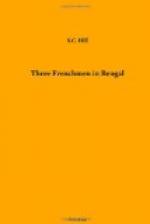MAPS AND PLANS
The Ganges Valley and the European settlements in Bengal, 1756. (After Rennell) Frontispiece
Map of the river Hugli from Bandel to Fulta. (After Rennell) To face page
Fort D’ORLEANS, chandernagore, 1749. (Mouchet)
Muxadabad, or Murshidabad. (After Rennell)
Dacca, or JEHANGIR-NAGAR. (After Rennell)
[Illustration: MAP OF THE RIVER HUGLI FROM BANDEL TO FULTA. (After Rennell.)]
THREE FRENCHMEN IN BENGAL
CHAPTER I
THE QUARREL WITH THE ENGLISH
Writing in 1725, the French naval commander, the Chevalier d’Albert, tells us that the three most handsome towns on the Ganges were Calcutta, Chandernagore, and Chinsurah, the chief Factories of the English, French, and Dutch. These towns were all situated within thirty miles of each other. Calcutta, the latest founded, was the greatest and the richest, owing partly to its situation, which permitted the largest ships of the time to anchor at its quays, and partly to the privilege enjoyed by the English merchants of trading freely as individuals through the length and breadth of the land. Native merchants and native artisans crowded to Calcutta, and the French and Dutch, less advantageously situated and hampered by restrictions of trade, had no chance of competing with the English on equal terms. The same was of course true of their minor establishments in the interior. All three nations had important Factories at Cossimbazar (in the neighbourhood of Murshidabad, the Capital of Bengal) and at Dacca, and minor Factories at Jugdea or Luckipore, and at Balasore. The French and Dutch had also Factories at Patna. Besides Calcutta, Chandernagore, and Chinsurah, the only Factory which was fortified was the English Factory at Cossimbazar.
During the long reign of the usurper, Aliverdi Khan,[1] that strong and politic ruler enforced peace among his European guests, and forbade any fortification of the Factories, except such as was necessary to protect them against possible incursions of the Marathas, who at that time made periodical attacks on Muhammadans and Hindus alike to enforce the payment of the chauth,[2] or blackmail, which they levied upon all the countries within their reach. In Southern India the English and French had been constantly at war whenever there was war in Europe, but in Bengal the strength of the Government, the terror of the Marathas, and the general weakness of the Europeans had contrived to enforce a neutrality. Still there was nothing to guarantee its continuance if the fear of the native Government




